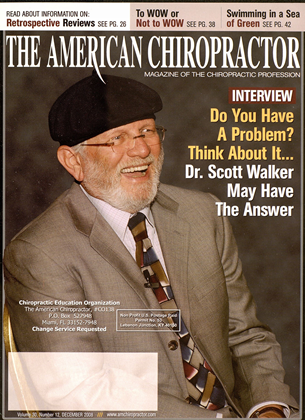History and Presenting Symptoms The patient is an active 5K-year-old male, with a history of participation in many team sports (baseball and football) in his younger years. He describes recurring pain and stillness in his right knee, which is especially noticeable in the mornings and also when he plays racquetbull or golf. He also has chronic mild-to-moderate pain in his lower back. He says he had numerous injuries to his knees many years ago, but no recent traumatic incidents. He hopes that chiropractic care can help him in both symptomatic areas. Exam Findings Vitals. This athletic, middle-aged man weighs 175 lbs, which, at 5* 10", results in a BMl of 25—he is right on the borderline of overweight. He works out regularly and is in very good condition, which indicates that much of his excess weight is likely to be lean body mass. He is a non-smoker, and his blood pressure and pulse rate are both within the normal range. Posture and }>ait. Standing postural evaluation finds a lower iliac crest on the right, and a low right greater trochanter. There is a lumbar list to the right, with compensatory balancing in the lower thoracic spine. His right knee demonstrates an obvious v algus alignment, and there is calcaneal eversion and hyperpro-nation on the right side. Gait testing finds a persistent flexion of the right knee, with an asymmetrical gait cadence. Chiropractic evaluation. Motion palpation identifies a limitation in segmental motion at L4/L5, with moderate tenderness and painful loss of end range mobility to the right. A compensatory fixation is noted at T9/T10. Neurologic testing is negative. Fxamination of the right knee finds no ligament instability, or evidence of patellar tracking problem. All knee ranges of motion are full and pain free. Manual muscle testing finds no specific muscle weakness around the knees or ankles. Imaging Weight-bearing X-rays of the right knee show mild loss of medial joint space, with small medial osteophytes. No advanced imaging is requested. Clinical Impression Moderate medial osteoarthrosis (previously osteoarthritis or degenerative joint disease) of the right knee, associated with alignment asymmetry of the right foot and ankle and hyperpronation. This is accompanied by pelvic and lumbar imbalance, with chronic lumbar spinal joint motion restriction and compensatory lower thoracic fixation. Treatment Plan Adjustments. Specific, corrective adjustments for the lumbar and lower thoracic spinal regions were provided as needed. Manipulation of the right knee into internal rotation was performed to decrease the external rotation associated with the chronic hyperpronation and valgus stresses. Support. Custom-made, flexible orthotics were provided to support the arches and decrease the medial stress on the knees. Rehabilitation. This patient was given elastic tubing exercises to strengthen his foot and ankle intrinsic musculature. He also used this device to strengthen the internal rotator muscles of his right hip. Response to Care He easily tolerated the spinal and right knee adjustments. He reported a rapid decrease in lumbar spine symptoms, and a substantial decrease in knee irritation during and alter athletic use. Within one week of receiving his orthotics, he reported that he was making it through the whole day with no right knee aching, and that his knee was much less stiff upon arising. He returned to his racquctball and golf with no problems, and was released to a self-directed maintenance program after a total of ten treatment sessions over two months. Discussion This case teaches several lessons. The most important is that pronation and biomechanieal asymmetry in the foot and ankle are seldom locally symptomatic. And chronic knee and back pain and degenerative processes must be evaluated fully, in order to identify the underlying problems and propose effective treatment. Anti-inflammatory drugs (which he had been using off and on for many years) did not address the primary biomechanieal problem. This condition was previously called osteoarthritis. but there is little evidence for an "itis" condition. Degenerative joint disease is also a misnomer, as this is not a "disease," and the degeneration process is directly associated with physical activity that the abnormally functioning joint can't tolerate. Optimal treatment of this condition is a comprehensive, conservative approach that combines chiropractic adjustments with flexible orthotic support. Dr. John./. Daiwhik is the seventh inductee to the American Chiropractic Association Spoils Hall oj Fame, lie is a clinical professor at Tufts University Medical School and for 25 years was the chairperson of the United States Olympic Committee's Chiropractic Selection Program. Dr. Daiwhik lectures extensively in the United Slates and nhroail on current trends in sports chiropractic and rehabilitation. He can be reached by e-mail at docfbr/ocs(auiol.com. V
 View Full Issue
View Full Issue






